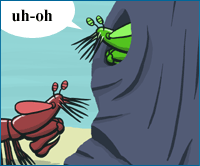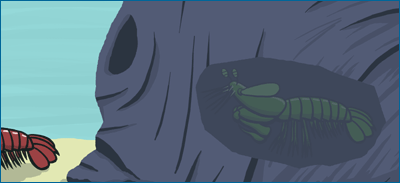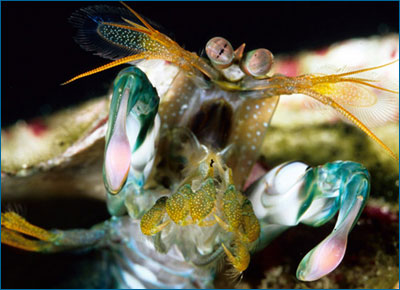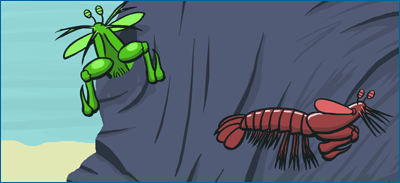 Imagine an N. bredini mantis shrimp quietly enjoying the safety of her cavity when a challenger appears outside. If she is not molting, the resident is likely to fight to defend her home — she may raise her forelegs in a threatening pose and then strike at the challenger. In this situation, the cavity defender is likely to win, because her body is protected within her cavity and her opponent’s is vulnerable. This is bad news for the opponent, who could be killed by the well-protected defender!
Imagine an N. bredini mantis shrimp quietly enjoying the safety of her cavity when a challenger appears outside. If she is not molting, the resident is likely to fight to defend her home — she may raise her forelegs in a threatening pose and then strike at the challenger. In this situation, the cavity defender is likely to win, because her body is protected within her cavity and her opponent’s is vulnerable. This is bad news for the opponent, who could be killed by the well-protected defender!
If the cavity defender is molting, however, it’s a different story. A molting mantis shrimp, still in the “squishy” stage, cannot fight successfully — she will only injure herself if she tries to strike at her opponent. In this case, the defending mantis shrimp has three options: she may flee, hide, or bluff.
- If she flees, the challenger will take over the cavity, but she will avoid injury in a fight:

- If she hides in the cavity, the new challenger may be wary of an ambush and not enter the cavity at all:
 On the other hand, if the challenger enters the cavity, the helpless defender will certainly lose her home and may be injured or killed and eaten:
On the other hand, if the challenger enters the cavity, the helpless defender will certainly lose her home and may be injured or killed and eaten: 
- She could also bluff — pretend that she is ready to fight, when, in fact, she is molting and totally vulnerable. In a bluff, the defender goes to the mouth of her cavity and holds out her forelegs, as though she were ready to strike:

Photo provided by Roy Caldwell. Since this signal generally indicates that a mantis shrimp is prepared to attack, it may intimidate the challenger into giving up without a fight:

Mantis shrimp would probably make quite wily poker players because they are so sophisticated about their bluffing strategies. For example, before bluffing, they seem to size up their opponent to determine how likely he or she is to be intimidated by the bluff — if the defender sees that her opponent is much smaller than her, she is more likely to try the bluff. If the defender sees that her opponent is larger than her, she is more likely to flee.
Mantis shrimp even try to “teach” their neighbors to take threats seriously, so that their bluffs are more effective. For example, a mantis shrimp whose exoskeleton is still hard but who is about to molt will increase her use of threatening displays, holding out her arms and then backing the display up with vicious strikes. This seems to give her neighbors the idea, “Whoa! Don’t mess with her!” After all, a cavity-invader risks death by attempting to oust a fully-protected mantis shrimp from her cavity. Then when the cavity defender actually goes into molt, loses her exoskeletal protection, and can no longer follow up a threat with a strike, her neighbors remember “not to mess with her” and shy away from her empty threats.
Water striders give us another excellent demonstration of trade-offs and molting.
